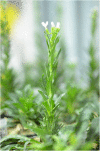The Boechera Genus as a Resource for Apomixis Research
- PMID: 31001306
- PMCID: PMC6454215
- DOI: 10.3389/fpls.2019.00392
The Boechera Genus as a Resource for Apomixis Research
Abstract
The genera Boechera (A. Löve et D. Löve) and Arabidopsis, the latter containing the model plant Arabidopsis thaliana, belong to the same clade within the Brassicaceae family. Boechera is the only among the more than 370 genera in the Brassicaceae where apomixis is well documented. Apomixis refers to the asexual reproduction through seed, and a better understanding of the underlying mechanisms has great potential for applications in agriculture. The Boechera genus currently includes 110 species (of which 38 are reported to be triploid and thus apomictic), which are distributed mostly in the North America. The apomictic lineages of Boechera occur at both the diploid and triploid level and show signs of a hybridogenic origin, resulting in a modification of their chromosome structure, as reflected by alloploidy, aneuploidy, substitutions of homeologous chromosomes, and the presence of aberrant chromosomes. In this review, we discuss the advantages of the Boechera genus to study apomixis, consider its modes of reproduction as well as the inheritance and possible mechanisms controlling apomixis. We also consider population genetic aspects and a possible role of hybridization at the origin of apomixis in Boechera. The molecular tools available to study Boechera, such as transformation techniques, laser capture microdissection, analysis of transcriptomes etc. are also discussed. We survey available genome assemblies of Boechera spp. and point out the challenges to assemble the highly heterozygous genomes of apomictic species. Due to these challenges, we argue for the application of an alternative reference-free method for the comparative analysis of such genomes, provide an overview of genomic sequencing data in the genus Boechera suitable for such analysis, and provide examples of its application.
Keywords: Boechera; apomeiosis; apomixis; diplospory; genome assembly; genomics; heterozygosity; pseudogamy.
Figures







Similar articles
-
Quantitative variation for apomictic reproduction in the genus Boechera (Brassicaceae).Am J Bot. 2010 Oct;97(10):1719-31. doi: 10.3732/ajb.1000188. Epub 2010 Sep 27. Am J Bot. 2010. PMID: 21616805
-
Does hybridization drive the transition to asexuality in diploid Boechera?Evolution. 2012 Apr;66(4):985-95. doi: 10.1111/j.1558-5646.2011.01507.x. Epub 2011 Dec 8. Evolution. 2012. PMID: 22486684
-
Asexual reproduction in a close relative of Arabidopsis: a genetic investigation of apomixis in Boechera (Brassicaceae).New Phytol. 2006;171(2):425-38. doi: 10.1111/j.1469-8137.2006.01765.x. New Phytol. 2006. PMID: 16866948
-
Boechera, a model system for ecological genomics.Mol Ecol. 2011 Dec;20(23):4843-57. doi: 10.1111/j.1365-294X.2011.05340.x. Epub 2011 Nov 8. Mol Ecol. 2011. PMID: 22059452 Free PMC article. Review.
-
The Boechera model system for evolutionary ecology.Am J Bot. 2022 Nov;109(11):1939-1961. doi: 10.1002/ajb2.16090. Epub 2022 Nov 13. Am J Bot. 2022. PMID: 36371714 Review.
Cited by
-
Phylogenetic and Expression Analysis of CENH3 and APOLLO Genes in Sexual and Apomictic Boechera Species.Plants (Basel). 2022 Jan 30;11(3):387. doi: 10.3390/plants11030387. Plants (Basel). 2022. PMID: 35161368 Free PMC article.
-
Predicting Cloned Disease Resistance Gene Homologs (CDRHs) in Radish, Underutilised Oilseeds, and Wild Brassicaceae Species.Plants (Basel). 2022 Nov 8;11(22):3010. doi: 10.3390/plants11223010. Plants (Basel). 2022. PMID: 36432742 Free PMC article.
-
Genome structure and molecular phylogeny of the only Eurasian Boechera species, Boechera falcata (Brassicaceae).G3 (Bethesda). 2025 Jul 9;15(7):jkaf117. doi: 10.1093/g3journal/jkaf117. G3 (Bethesda). 2025. PMID: 40539638 Free PMC article.
-
Whether Gametophytes are Reduced or Unreduced in Angiosperms Might Be Determined Metabolically.Genes (Basel). 2020 Dec 2;11(12):1449. doi: 10.3390/genes11121449. Genes (Basel). 2020. PMID: 33276690 Free PMC article.
-
New facts about callose events in the young ovules of some sexual and apomictic species of the Asteraceae family.Protoplasma. 2022 Nov;259(6):1553-1565. doi: 10.1007/s00709-022-01755-0. Epub 2022 Mar 19. Protoplasma. 2022. PMID: 35304670
References
-
- Alexander P. J., Windham M. D., Beck J. B., Al-Shehbaz I. A., Allphin L., Bailey C. D. (2013). Molecular phylogenetics and taxonomy of the genus Boechera and related genera (Brassicaceae: Boechereae). Syst. Bot. 38 192–209. 10.1600/036364413X661917 - DOI
-
- Al-Shehbaz I. A. (2003). Transfer of most North American species of Arabis to Boechera (Brassicaceae). Novon 13 381–391. 10.2307/3393366 - DOI
Publication types
LinkOut - more resources
Full Text Sources
Miscellaneous

